Pieter de Nijs
MARCEL DUCHAMP AND ALFRED JARRY*
*[Pieter de Nijs, Marcel Duchamp and Alfred Jarry, RELIEF 10 (1), 2016, pp. 77-98.]
Alfred Jarry (1873-1907) is usually presented as one of Marcel Duchamp’s literary examples. Duchamp however never explicitly named Jarry as such; unlike he did with Jules Laforgue, Raymond Roussel and Jean-Paul Brisset. The reason why Jarry is nevertheless often mentioned as one of Duchamp's major inspirations lies in some – mainly thematic – parallels between their works. Duchamp's ‘amusing physics’ (physique amusante) seems to be directly inspired by the pataphysics Jarry introduced in Gestes et opinions du Docteur Faustroll, pataphysicien (1911). The fantastic machines Jarry staged in a novel like Le Surmâle (1902) and in the various stories he wrote for magazines such as La Revue blanche, La Plume and Le Canard sauvage have traces in common with the machineries Duchamp gave shape in – for example – his La Mariee mise à nu par ses célibataires, même. And Duchamp sometimes did refer directly to Jarry, for example to his famous 'merdre'.
More interesting though then the thematic parallels are the linguistic experiments Jarry and Duchamp both ventured on, showing some striking similarities.
As Duchamp’s work relates critically to the art practice of the 20th century, so the novels and stories of Alfred Jarry relate critically to the literature of (the end of) the 19th century. In themes and language, Jarry’s work is closely linked to the literature of symbolism, but at the same time it exhibits a trend that was also evident in the work of the artistic groups around popular cabarets like Le Chat Noir – groups that adorned themselves with fanciful names like Hydropates, Zutistes, Jemenfoutistes and Incoherents. The work of these writers, poets, caricaturists, singers and artists – collectively referred to as fumistes (jokers) – made it clear that the boundaries between elite and popular culture around 1900 were fading rapidly.[1]
By introducing elements originating from a 'low' culture in literature, Jarry was one of the first literary authors who, around 1900, put into question the current hierarchical relationships between high and low culture. His Ubu Roi bears obvious traces of its original conception, the puppet show Les Polonais, written by the two brothers Morin, when they were all three students at the lycée in Rennes. In later texts, Jarry regularly alluded to his preference for puppetry rather than a theatre with 'living' authors (see Jarry, OE I, 405-410). Jarry's adolescent humor, the clear emphasis on the scabrous and scatological and the frequent alternation between different literary and cultural registers in his work are easily related to tone and themes in the work of the fumistes, for instance, to the parodies and satirical songs and speeches belonging to the usual repertoire of the Montmartre cabarets, but also to the puppet and shadow plays that were staged there.[2]
Duchamp is being held accountable for a similar, perhaps even more serious – because verging on degradation – popularization of the arts. The examples are well known: the ‘desecration’ of one of the icons of Western art, Leonardo's Mona Lisa, to 'chick with a hot ass’ (LHOOQ), the exhibition of a urinal as a work of art (Fontaine), the 'elevation' of a vulgar diorama to a museum work (Etant donnés) – Duchamp even had the audacity to present an ordinary specimen of his own semen as a work of art (Paysage Fautif).
Duchamp's work, particularly his early drawings, can easily be related to the fumistic humour cult. As a young artist Duchamp earned his money almost exclusively with the production of cartoons for magazines such as Le Rire and Le Courrier Français – drawings with punning, often scabrous, titles and captions that would not have gone amiss in the exhibitions of the Incoherents. And Duchamp's readymades are at first sight as iconoclastic as the work of, for example, Sapeck (Eugène Bataille), one of the most (in)famous fumistes.
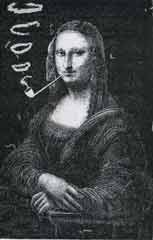
Sapeck: Mona Lisa with pipe, 1883 or 1887
A mechanical image of love
La Mariee mise à nu par ses célibataires, même –
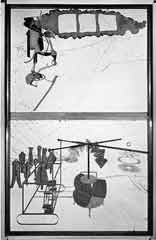
Marcel Duchamp: The Bride Stripped Bare by Her Bachelors, Even (The Large Glass), 1915-23, oil, varnish, lead foil, lead wire, and dust on two glass panels, 277.5×175.9 cm
according to Duchamp’s own words one of his most important works – is a painting on glass plates, one above the other (hence the nickname The Great Glass). Its lower part is dominated by machines like the Sleigh or Glider, the Water Mill and the Chocolate Grinder. The metal casings to the left and above the Sleigh are the Bachelors. Nine thin tubes (Tubes capillaires) are leading to a series of seven cones, filters or Seives (Tamis), which together form a semicircle above the Chocolate Grinder. The three silver ellipses to the right are the Oculist Witnesses (Témoins oculaires). In the upper part of the glass an insect-like shape, with spiky feelers and metallic appendices, hangs on a kind of hook. That's the Bride (Mariée). She is also referred to as ‘the female hanged’ (Pendu femelle).
The Glass is, judging by its title, a sort of erotic display. In the notes Duchamp published alongside the Glass this ‘exhibition’ is described in ostensibly scientific terms, sometimes referring to mechanics, sometimes to physics, physiology or biology.[3] Duchamp specifies that the bachelors desire the undressing of the Bride, a desire which is transmitted by means of ‘love-gas(oline)’ (essence d'amour), but could also be transferred via ‘commands’ (i.e. lingual messages) or through photographic means.
Jarry’s machines are easily related to the humanoid machinery in the Great Glass. Le Surmâle (1902) features a quintuplette, a tandem for five cyclists strapped onto their bikes, their legs interconnected by rods.
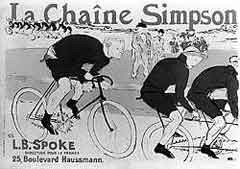
Toulouse Lautrec, La Chaîne Simpson, 1896
The cyclists are being fuelled by a synthetic drug, the Perpetual Motion Food, an invention of the American engineer William Elson. The quintuplette competes with a steam train in a race over ten thousand miles from Paris to Irkutsk and back. André Marcueil, the 'superman', ‘illegally’ enters the competition. He quite easily succeeds in defeating both the cyclists on their quintuplette as the steam train. The energy for this inhuman performance lies not in a drug, but in the attraction of Ellen, William Elson’s daughter, who inflames the Superman from one of the train cars. Marceuil - a ‘bachelor’ - finds in Ellen his motor (‘Ellen l'entraîne’).
In one of the following chapters Marcueil delivers a second proof of the statement he made in the beginning of the novel, namely that there is no limit to the human forces. He takes on the challenge of a love duel, in which he will attempt to attain at the mythical limit of ‘eighty times in one night’ of Theophrastus’ ‘Indian’ (a startling feat recorded, according to Jarry, in Rabelais’ Pantagruel, III, chapter 27). Ellen and Marcueil perform their love duel with mechanical precision. Together they break through the mythical limit but the exploit has no lasting effect on Marceuil – much to Ellen’s distress. At the request of his daughter, Elson constructs a ‘machine à inspirer l'amour’ to force Marcueil to infatuation. Unfortunately the love flow emanated from the machine backfires, and it is the machine that falls in love with the man. The result is a short circuit and (for Marceuil) a deadly embrace. Jarry's ’novel of ancient Rome’, Messaline (1901), has a similar theme. As Juvenal states in his Satires (VI), Messalina, the wife of Emperor Claudius, was being plagued by an unquenchable desire for sexual gratification. Much like Marcueil, Messalina makes love as an automaton, but even in the brothels she frequents as a prostitute she does not find fulfilment.
Like Duchamp in his Large Glass, Jarry in these novels presents us with a mechanical image of love.
Collages
In his notes Duchamp describes his Glass as ‘a repository of loose ideas’, and anyone who sees the painting understands this description immediately. The ‘story’ of the Glass can absolutely not be derived from the bizarre collection of phenomena Duchamp depicted. Without the accompanying text from the boîtes it is hard to find a link between the various components the Glass is composed off. The Glass is a collage in the original sense of the word: a merging of forms that do not fit well together.[4]
Here lies another link with the work of Jarry. Jarry, although heavily influenced by the ideas of symbolism, is not a symbolist pur-sang. Like Duchamp’s Glass, his works can be characterized as collages.
Jarry drew his text material from a wide variety of sources: from the literature and art of his (Symbolist) contemporaries and the books he read in his childhood, to philosophy and the work of admired authors such as Rabelais. He browsed in alchemical or esoteric writings, in dictionaries and encyclopaedias as the Grand Dictionnaire universel du XIX siècle (Larousse) and in popular scientific journals such as the Magasin pittoresque. He even made a literary use of terminology derived from mathematics and natural science.
In his work Jarry demonstrates an exceptional ability for travesty – for translation, retranslation and manipulation off the linguistic material he borrowed from literary predecessors and contemporaries. This is most obvious in Gestes et opinions du docteur Faustroll, pataphysicien. Faustroll has a chaotic structure and the content resembles an inverted desk drawer: Jarry interchanges hermetically-symbolist passages with official texts, philosophical (or quasi-philosophical) reflections, and seemingly correct mathematical equations and quotes from scientific treatises.
The protagonist of the book, Doctor Faustroll is, judging by his name, himself a collage: his name refers both to the legendary Doctor Faustus and to the mythical figure of the troll. The second protagonist, a bailiff, is adorned with the significant name Panmuphle.[5] The third main character is the baboon Bosse-de-Nage. His contribution to the story is limited to an at all times applicable and thus utterly meaningless exclamation: Ha-ha.
This alternative Trinity embarks on a ‘quest’ along a series of 'islands'; a journey through the world of symbolism, of which the book charts the fictional landscape, with distant shores, dangerous cliffs and island paradises. These islands are a kind of prose poems, made up of phrases and images derived from prominent Symbolist artists and writers, such as Audrey Beardsley, Emile Bernard, Paul Gauguin, Pierre Bonnard, Léon Bloy, Gustave Kahn Stéphane Mallarmé, Marcel Schwob, Rachilde and Paul Valéry. Each island is built according to its own laws and out of its own material. The Roi de dentelles (King of Lace) for instance weaves his island out of the fine arabesque lines that separate darkness from light – a reference to the Art Nouveau style of Audrey Beardsley. The island Ptyx is shaped like a sonnet by Mallarmé: a hard and polished block of stone that shines like a diamond. But there is also a Baron Hildebrand, ruler of ‘L’Ile de Bran’, an island of shit.
The journey doesn’t end well. In an apocalyptic rage Faustroll strangles Bosse-de-Nage and subsequently destroys earth and its inhabitants in seven days. Panmuphle disappears into oblivion; the doctor himself takes refuge in a ‘realm of unknown dimension’. From there he sends telepathic letters to the renowned physicist Lord Kelvin, in which he muses about fundamental physical problems as the age of the sun, the structure of the ether and the means one has to resort to determine one’s position in a vacuum without such earthly tools as the yardstick, the watch or the tuning fork.
Pataphysics and ‘physique amusante’
In Faustroll Jarry regularly quotes from popular scientific publications and brochures in which is referred to (often seemingly bizarre) experiments by scientists as C.V. Boys, William Crookes and William Thomson (Lord Kelvin) – for instance to the imaginatively inspiring way Boys was able to produce quartz thread (Boys used a crossbow) and to his study of the surface strength of water and other liquids (a study Boys made accessible to the public in Soap Bubbles: Their Colours and the Forces Which Mould Them (1890), with recipes, experiments and experiments with (soap) bubbles, which could also be performed by young children – an example of the ‘physics for the living room’, or physique amusante[6]).
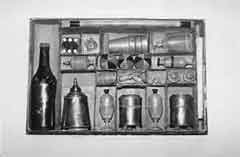
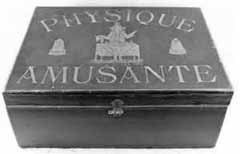
a 19th century 'boîte de physique amusante'
Jarry also refers to Maxwell’s ‘demon’ and the theory of the ether developed by Lord Kelvin.[7] His referring to these experiments and theories proves that Jarry was aware of the developments in contemporary science, even though he chose to favour those theories and experiments that have an inherent 'pataphysical’ quality.
Pataphysics is Jarry's private science. With pataphysics Jarry gives his own interpretation of theories about the relativity of the (human) perception that arose at the end of the nineteenth century. For the story of Faustroll who – microscopically small – explores the structure of a cabbage leaf (chapter 9 of Faustroll) he relied on a lecture by William Crookes. And in the 'telepathic letters’ Faustroll sends to Lord Kelvin (chapter 37 of Faustroll) Jarry refers to elements from several readings of Kelvin (published in French as Conférences scientifiques et allocutions in 1893). In this chapter Faustroll complains about the fact that, in ‘the realm of an unknown dimension’ where he has been trapped, the centimetre that he always carried with him –‘an authentic brass copy of the standard unit’- is lost, forcing him take resort to such basic objects as a piece of glass, and a pair of candles to orientate himself.[8]
It is tempting to trace back Jarry's preference for these imaginative scientific texts to the experiments of his former physics teacher Hébert (or Père Eb, upon whom Ubu in Ubu Roi was based), that invariably failed, or to the physique amusante. More likely Jarry was seized by the growing understanding that there were no absolute valid statements about physical phenomena and that statements based exclusively on the human perception were rather unreliable, because every observation is dependent on the position of the observer and the reference points on which he relies himself.
Jarry seems well aware of these new insights. The laws that everyone normally accepts as valid also depend on conventions – on the way we have learned to look upon reality, Jarry suggests (in chapter 8 of Faustroll). After all, ‘Why does everybody confirm that the shape of a watch is round, which is clearly false, because it is a narrow rectangle as you see it in profile, and an ellipse as one sees it from three quarters .... And why is that form only noticed when one looks at what time it is?’
Every law has its exceptions, Jarry stresses, and these exceptions and deviations form the core of his pataphysics. In Faustroll he defines pataphysics as ‘the science of imaginary solutions’. Mainstream science tries to embed a phenomenon logically into a system of rules and explanations, with the underlying idea that the strength of the declaration system increases when it includes and predicts the activities of as many phenomena as possible. Pataphysics rejects the universally valid laws and instead asks attention for the deviation or exception. She focuses preferably on the epiphenomenon, on what usually escapes the attention of mainstream science because it falls outside the laws that are conventionally used to explain phenomena. Pataphysics isolates such separates phenomena from the obvious chain of cause and effect, and assembles them into a new context, so that they acquire a new meaning.
Jarry's private science is comparable to Duchamp's ‘amusing physics’. Both Jarry and Duchamp regularly resort to formulations that have been borrowed from mathematics or science. And both at least strike an ironic tone. Like Jarry Duchamp refers to the relativity of human perception. His aphorism ‘Si une pendule est vue de côté, elle ne donne plus l’heure’ seems a direct reference to Jarry's remark about the way people view a watch. Both also make a mockery of current understanding of the scientific and physical phenomena. The epiphenomena Jarry refers to show up in Duchamp’s 'emancipated' metal, which shrinks and expands according to its own free will, or in objects with an ‘oscillating density', which makes them independent of gravity. (Writings 30) In Duchamp's manipulation of the standard meter, which resulted in the 3 Standard Stops (3 Stoppages étalon), and in the notion mètre diminué resound Jarry's parodic words from chapter 37 of Faustroll about the trust scientists put in the ordinary measuring instruments. Duchamp incidentally refers directly to Jarry's pataphysics where he states that in his Stoppages étalon the meter ’was changed from from a straight line to a curved line without actually losing its identity [as] the meter, and yet casting a pataphysical doubt on the concept of a straight line as being the shortest route from one point to another’.
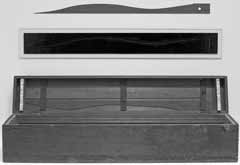
Marcel Duchamp: 3 Standard Stops (3 Stoppages étalon), 1913-14
The circle and the line
Jarry was an avid cyclist and the bike was his favourite means of transport.
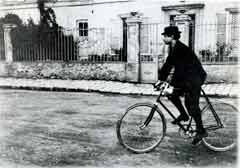
Alfred Jarry on his bicycle (a 'Clément luxe 96 course sur piste')
The bike also plays a prominent role in his novels and stories. In ‘La Passion considerée comme course de côte’ (1903), a parody of the Passion story in the form of a report of a bike race, Christ climbs Mount Calvary on a bicycle. In this text Jarry ’crosses' the bike literally with the cross of Christ. And in his ‘Commentaire pour servir à la construction pratique de la machine à explorer le temps’ he constructed a time machine around a set of gyrostates, built into an ebony bicycle frame.
Critics have noted the similarity of Jarry's Passion text with Duchamp’s drawing Avoir l'apprenti dans le soleil.
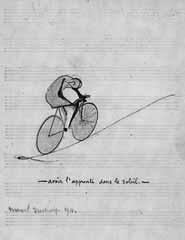
Marcel Duchamp: To Have the Apprentice in the Sun, 1914, india ink and pencil on music paper. (Philadelphia Museum of Art)
The combination of elements in the drawing (a cyclist, bending over heavily, whilst riding up over a curved geometric line) is strongly reminiscent of the fantasy Jarry expressed in his Passion text. The drawing may be a foreshadowing of the image Duchamp used in his notes for the growing desire of the Bride, which he described as the increasingly arduous roar of a car, climbing a slope in its lowest gear. (Writings 34). Duchamp's text La route Jura-Paris, a reflection of a journey by car from the Jura to Paris Duchamp made in 1912 in the company of Francis Picabia, Gabrielle Buffet and Guillaume Apollinaire, can also be associated with Jarry's machines. The quintuplette from Superman is staffed by five cyclists; in La route Jura-Paris Duchamp refers to a 'machine' à cinq coeurs’ (machine with five hearts).[9] That the quintuplette is being paced by a comet-shaped automobile seems to echo in Duchamp's text, when he states that the ‘enfant-phare’ (the ‘headlight child’) 'graphically' resembles a comet 'with its tail forward, absorbing the road Jura-Paris'; Duchamp specifies that this road is rather 'indefinite' than 'infinite'; it is a road that ‘graphically […] will tend towards the pure geometrical line’. (Writings 27)
Duchamp's formulation is similar to one of Jarry's favourite images: that of the circle or the circular motion, which eventually 'dissolves' in a line stretching into infinity.[10] The race between the steam train and the quintuplette has the significant nickname ‘perpetual motion race’. For one of the cyclists it actually turns into an endless race: Jewey Jacobs dies on the quintuplette – a result of the accelerated metabolism that the Perpetual Motion Food entails – and his legs are stalled due to the onset of rigor mortis. The other cyclists however manage to break through this stiffening, resulting in Jewey’s’ dead legs functioning as a flywheel. The poor cyclist would, if necessary, be able to gyrate through in perpetuity.
Joyless repetition
The central theme of Le Surmâle is putting an end to circular movement, to break the cycle of repetitive motion. This is reflected in the love duel Ellen and Marcueil perform. Ellen is left seemingly lifeless after yet another 'attack' by Marcueil, though she wakes up effortlessly in the next chapter (her death is a petite morte, the fin de siècle euphemism for the female orgasm). Marcueil, on the contrary, is adrift. Thanks to his (literally) rigid control over his bodily functions he breaks through the limit of the human-impossible, symbolized in the figure (80 x overnight), and thus succeeds to reach out to infinity, where the power of numbers no longer reign. Marcueil breaks free (as Faustroll?) from the restrictions life and love imposes on human existence and from the mechanics that – in biological sense – focuses on the endless production of ever new (mechanically-responsive) creatures.
Here is a given that digs deeper than the thematic similarity between the work of Jarry and Duchamp. Duchamp repeatedly stated that he tried to avoid lapsing into repetition. On a personal level, he often expressed his preference for the status of bachelorhood. Many of the cartoons he made in the beginning of his career render an ironic look at courtship and – above all – at the sad routine of married life, which often amounts to joyless and quasi-mechanical procreation.
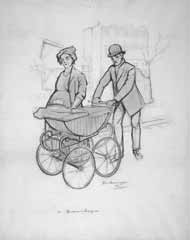
Marcel Duchamp: Sundays (Dimanches), 1909, conté pencil, brush, and 'splatter' on paper. (The Museum of Modern Art, New York; promised gift of Mary Sisler.)
La Mariée mise à nu par ses célibataires, même – at least partly – seems to express the idea of (sterile, infertile) love and the fundamental impossibility of an actual unification of bachelor(s) and bride.[11]
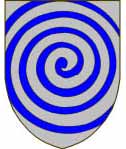
The ‘maelstrom’ (gouffre), blazon of Ubu Roi
Maelstrom
It is not difficult to link the infertile copulations of Jarry's heroes and heroines (Marcueil and Ellen and Messalina and her lovers), to the machinery in Duchamp's Large Glass, to the movement of the Sleigh, which according to Duchamp’s notes, monotonously slides back and forth, or to that of the Chocolate Mill, rotating in a similar monotonous litany – activities to which Duchamp gives a sexual connotation with words such as ‘onanism’ and ‘vie célibataire'. (Writings 56) And when it comes to ‘love as the driving force’ there are more scenes from Jarry's novels and stories Duchamp could have taken as an example. But it remains to be seen whether Duchamp was as much aware of Jarry’s work as sometimes is suggested. Unfulfilled, unfulfillable or sterile love is a theme that pops up frequently in the literature of the late 19th century. In the work of Jules Laforgue example, an author who Duchamp cited especially as one of his literary examples.[12]
Moreover, the question remains whether Jarry's machines are to be seen as actually 'mechanistic'. They are, after all, imaginary machines, verbal machines, with one function only: to demonstrate (paraphrasing the thesis of André Marceuil) that the author's imagination is limitless. For Jarry the 'machinelike grinding’ is an image for writing itself - a metaphor for the process which was designed to exhaust all possible significations and verbal relationships of words, bringing to the surface all suspected (or suggested) underlying significations and relations between them.
Besides being an avid cyclist Jarry was an avid reader, who in his novels, stories and poems incorporated everything he considered useful. In doing that he made no fundamental distinction between his own feelings and insights and the words and insights he had picked up through his reading. He even seemed to like to ‘forget’ that such a distinction really exists. In the 'maelstrom', the continuous circular process that was going on in his mind, it was as if the distinction between the self and others became blurred.[13]
To digest these impressions – food for the imagination – faster, man according to Jarry would benefit from an external skeleton, like that of a bicycle, as an extension of his body: ‘il devait se server de cette machine à engrenages pour capturer dans un drainage rapide les formes et les couleurs, dans le moins de temps possible, le long des routes et des pistes; car servir les aliments à l’esprit broyés et brouillés épargne le travail des oubliettes destructives de la mémoire, et l’esprit peut d’autant plus aisément après cette assimilation recréer des formes et couleurs nouvelles selon soi.’ (Les Jours et les nuits, 1897, in OC I 770)
Language manipulation
In 'Linteau’, the preface to his first publication Les Minutes de Sable Memorial (1894), Jarry formulated his literary program as follows: ‘Suggérer au lieu de dire, faire dans la route des phrases un carrefour de tous les mots’ (‘to suggest instead of saying, creating an intersection of all the words in the course of the sentences’). Jarry defines the word as ‘a polyhedron of ideas’. In every word condensed multiple meanings can be found that resonate in the sentence and can be evoked by association in sound and meaning. Jarry interlinks sounds and words from one language through an apparently common root effortlessly with sounds and words from another language, without taking into account the common laws of language or language families. To enhance the many facets of the word he places verbs and attributes on an unusual position in the sentence, links incongruent images, and creates new words from completely distinct idioms or languages. He regularly reverts to the use of phonetic or graphical deformation of the word, to conversion of letters or words, using or suggesting (possible) relationships between words based on phonetic similarities or resemblances (rose/eros//héros; l'amour/la mort; rigor/amoris /rigor mortis), to anagrams and palindromes (UBU, ROMA/AMOR), to a particular spelling (phynance, muphle, merdre) and (quasi) etymological derivations (pal/phallus)/Phalès/palotin).[14] Sometimes the distinction between different sign systems disappears completely: a letter can be interpreted both as a sound, a mathematical sign and as a religious or mystical symbol. The final chapters of Faustroll contain some explicit examples. Chapter 39 (subtitle: ‘According to Ibikrates the mathematician’) is both a paraphrase on and a parody of the dialogues of Plato. Ibikrates' name, says Jarry, is derived from Ybex and Ybex is the archetype of Ubu (Y = U). In heraldry the Y is called the fork (in French: pairle, also the name of one of Ubu's palotins).[15] In Christian symbolism, the Y is the bifurcated cross known as the Ypsilon cross or furca: a cross with two arms angled diagonally upwards. Christ was supposed to have died on such a cross (and not on the much more familiar cross with a horizontal crossbar). In Hebrew - as is known - the Y is the first letter of the name of God, YHVH. However, the Y is also a symbol for the androgyn, as the combination of two elements, the female (according to Jarry the letter V or U) and the male (the letter I), and thus of the homunculus or hermaphrodite, the end product of the unification of opposites. Jarry is eager to deplete all symbolism assigned to the Y. He even resorts to non-literary character systems. In the last chapter of Faustroll the graphic sign Y changes into a mathematical diagram (the triangle), which leads to a speculation about the Holy Trinity, and – in the last chapter – the starting point for a calculation of ‘the surface of God’.
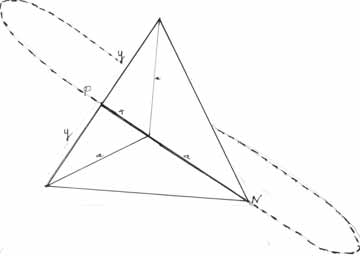
Jarry's 'surface of God' (drawing by Liesbeth van Nes) (from: Alfred Jarry, Roemruchte daden en opvattingen van doctor Faustroll, patafysicus, Amsterdam: Bananafish, 2016)
Private logic and private language
In my view, this constitutes a more evident similarity between the work of Jarry and Duchamp then in comparable themes. In the titles of his work, in his readymades and in his wordplay Duchamp reverts to methods and tools Jarry uses too: a private spelling, uncommon or unusual grammatical constructions, converting and adding of letters (anagram, palindrome), and a frequent use of homophony and paronomasia to establish relationships between words that seemingly have no connection or relationship.
Both follow their own logic, in which seriousness and irony alternate and are complementary. This irony and peculiar logic speaks clearly from one of Jarry's short essays, 'Ceux pour qui il n'y eut point de Babel'. In this essay he quotes the words of Victor Fournié, the author of an Introduction à l'Histoire ancienne (1901), which demonstrate clearly that ‘for those who can read, the same syllable in all languages have the same connotation’. (OC I 441-442) Jarry discusses some of the examples supporting this proposition. ‘Nous appelons l’alphabet: a-b-c: les trois premières lettres. Alpha-bet (alpha-beta) est la même dénomination en grec. Au lieu de lettres prenez les chiffres, vous aurez l’appellation, formée de même, du calcul, l’industrie: in-dus-tria : un, deux, trois, dans toutes les langues.’ This remarquable enumeration continues: ‘TEN, dix, les dix doigts, le grand chef, thane (thane de Glamis et thane de Cawdor).’ And Jarry in his turn adds: ‘Nous ajouterons aux documents de M. Fournié cette racine – ou cette gencive – avec des corollaires: Zaehne (prononcez Tzêne), en allemand les dents, comme zehn, dix. D’où le grand chef : celui qui mord, le loup, celui qui porte l’arme tranchante. Ces vocables sont ceux du Nord, monarchiques. Les peuples du Midi à instinct démocratique, ont dit: δάκτυλος, tous les doigts, decem, DUX… Nous ajouterons : διδάτκω, διδακταλος, le maître.’ Jarry then refers to Bergson (his former teacher of philosophy), who defined laughter as ‘the feeling of surprise’: ‘Nous estimons qu’il faudrait ajouter: l’impression de la vérité révélée – qui surprend, comme toute découverte inopinée. Voilà pourquoi nous citons d’abord M. Fournié. Les allitérations, les rimes, les assonances et les rythmes révèlent des parentés profondes entre les mots. Où dans plusieurs mots, il y a une même syllabe, il y a un point commun.’
Of course it remains the question whether we must take Jarry seriously here. His entire reasoning, including 'the impression of revealed truth’ has conspicuous similarities with the inimitable etymological derivations of Jean-Paul Brisset, who thought the origin of the human race was to be found in the French language, and claimed (without any irony) that man was descended from the frog – a principle that was given in the sound of words themselves: ‘société’, after all, sounds the same as ‘en ce eau y était’. Given the admiration Duchamp said to have had for Brisset the continuation of Jarry's text would surely have amused him. Jarry notes that fellow author Franc-Nohain ‘sait à merveille, déterrer les racines des mots’. After all: ‘Quand il écrit: « Escargot, Escarguerite », il le déduit logiquement de « Margot, Marguerite ». Si d’aucuns contestent que Marguerite soit le féminin de Margot et n’y reconnaissent que le diminutif, – le féminin, répondrons-nous, n’est-il pas un diminutif ? sinon nos femmes seraient trop grandes!’
The etymological reasoning of Franc-Nohain which Jarry cites with assent resembles the grammar rule formulated by Duchamp: ‘Si vous voulez une règle de grammaire: le verbe s’accorde avec le sujet consonnament: Par exemple: le nègre aigrit, les négresses s’aigrissent ou maigrissent.’ (DDS 159) As with the language law Franc-Nohain according to Jarry supposedly has uncovered, the surprise (and humour) in Duchamp’s 'grammar rule' lies in the inimitable, but by no means debatable logic with which it is being presented.
Nominalism
Duchamp’s notes clearly show that during the years he was working on his Great Glass (from 1912 to 1923), Duchamp was actively seeking the most appropriate, precise and unique designation of the different components the Glass consists off. His search for that exact terminology was being accompanied by concerns about the possibility of detaching words (and even letters) from their usual context to give them their own plastic value (‘une forme à signification plastique’). Duchamp searched for words or names that were distinct and unique and not ‘équivoque ' i.e. ambiguous or unclear. Thus the names he gave various parts of the Great Glass – Moules mâliques, Tubes capillaires, Témoins oculaires, Stoppages-étalon – are unique names, singular names for singular 'objects'.
In his notes Duchamp toyed with the idea of overthrowing the common grammatical rules (rules that concern the relationship between subject and verb, the conjugation of the verb, the difference between singular and plural, etc.) and designing a new set of rules. Sounds and words, once freed from their (semantic) content and grammatical restrictions, might enter into new relationships in an alternative arrangement, with surprisingly new shapes - and thus with new insights into these relationships – as a result. Duchamp previously cited 'grammar rule' is an example: it posits the primacy of the relationship between words in sound, not in the usual grammatical relations. The same goes for his puns and aphorisms; they are both an illustration of Duchamp’s ‘grammar rule’ and of the surprise based on the linking of words that at first sight are not related, but at second sight do appear to be linked to each other, purely on the basis of similar sounds: ‘Rrose Sélavy et moi esquivons les ecchymoses des Esquimaux aux mots exquis '; ‘Daily lady cherche démêlés avec Daily Mail’; Or: ‘On demande des moustiques domestiques (demi-stock) pour la cure d'azote sur la Côte d'Azur.’
Eventually Duchamp ended up with a more radical conception of a language in which every word carries its own unique ‘name’ that cannot be confused with another name, and does not refer to a universal concept outside itself. Already in 1914 he used the term ‘nominalism’ to refer to this conception of language:
[…] Nominalisme [littéral] = Plus de distinction générique / spécifique / numérique / entre les mots (tables n’est pas le pluriel de table, mangea n’a rien de commun avec manger). Plus d’adaptation physique des mots concrets; plus de valeur conceptique des mots abstraits. Le mot perd aussi sa valeur musicale. Il est seulement lisible (en tant que formé de consonnes et de voyelles), il est lisible des yeux et peu à peu prend une forme à signification plastique ; il est une réalité sensorielle une vérité plastique au même titre qu’un trait, qu’un ensemble de traits. […] » (MDN # 185rv).
Duchamp’s 'grammar rule’ is consistent with his belief that words need to be read on their own (nominal) value and that the usual order current grammar and syntax rules impose upon the words are much less meaningful than the order that speaks from similar sounds or notation.
Jarry apparently chose for a similar premise.
Inframince and indifference
From 1913 on, Duchamp (as Herbert Molderings states) was looking for a way to create a body of work in which images and words are combined into a new kind of work, ‘ou un élément n'explique l'autre pas mais où les deux poursuivent un mouvement perpétuel sous forme d'unité des contraires.’ (Molderings 100) For those ‘two elements in perpetual motion in the form of a unity of opposites’ Duchamp finally coined the term inframince. That concept cannot be defined and may, according to Duchamp, best be illustrated by using examples: ‘La chaleur d'un siège (qui vient d'être quitté) est infra-mince’ (MDN # 4), or ‘Quand la fumée de tabac sent aussi de la bouche qui l’exhale les 2 odeurs s’épousent par infra mince.’ (MDN # 11v)
Inframince means that certain properties or effects of a phenomenon (a word, an object) may be transferred or passed on to a second phenomenon (word or object). In MDN the first note reads: Le possible est un infra mince. [...] Le possible impliquant le devenir –. Le passage de l'un à l'autre a lieu dans le infra mince'. Inframince is indicative of a transition (passage), and not of a (static) situation. Duchamp used the term inframince as an instrumental tool to get and keep moving what presents itself to our senses. Whether it is a urinal that can no longer be called a urinal because it has been named differently, or a cliché of beauty (the Mona Lisa) nobody ever devotes a deeper thought to because it has become a stereotype: he aimed at breaking fixation; not at a static but at a dynamic perception.
For Duchamp, the concept inframince was directly linked to indifférence - a word best translated as indeterminacy, as an indication of an ongoing (freedom of) movement and change. In the words of Thierry de Duve: ‘The infra-thin separation is working at its maximum when it distinguishes the same from the same, when it is an indifferent difference, or a differential identity.’ (De Duve 160) Duchamp gave this 'indifferent difference' or 'differential identity' a sound basis when he took on the identity of R(r)ose Sélavy (in 1920). Rrose is the personification of the principle of inframince. Rrose is not a man, nor a woman, and certainly no transsexual. Rrose is Marcel and Marcel is Rrose. The identity of Marcel/Rrose oscillates constantly: it is a – paradoxically – active status or condition with an ‘identity’ that depends on the perspective chosen.[16]
Duchamp's indifférence resembles the ‘principe des contraires identiques’ Jarry introduced as the basis of pataphysics in his curious play César Antechrist, and to which he explicitly referred to in the previously mentioned chapter of Faustroll, ‘According to Ibikrates the mathematician '. Jarry defines this principle as a union of ‘God and the Antechrist, of Plus and Minus’: ‘Axiome et principe des contraires identiques, le pataphysicien […] est par toi l’Antechrist et Dieu aussi […], Moins-et-Plus, Moins qui-es-Plus […].’ (OC I 290) In César-Antechrist Jarry noted in a highly condensed form what he strove for with his entire work: a condensation of the sign or word, occasioning the emergence of cross-references to texts from different disciplines and different times. Jarry's writing was focused on the deranging of words, shaking them out of their usual context, disassembling and reassembling them in a new order. Jarry rejected the usual way of reading and writing, based on the linearity of the text, in favour of a text that wheels out from a centre, or draws words centrifugally to a centre from where they can enrich themselves through association and then radially wheel out again. In this way the word transcends its unambiguous meaning: its meaning is kept in constant vibration, allowing it to transcend the continuity of the text, creating a time bridge and crossing the gap to other texts, enabling it to move freely in an area where it can denote different, even opposite concepts at the same time.
Like Jarry Duchamp aimed at keeping meaning in constant vibration. The ultimate difference between Jarry and Duchamp lies in their intentions. In a letter to a friend Duchamp called himself a nominalist 'in its simplest form': ‘I do not believe in language, which instead of expressing subconscious phenomena in reality creates thought by and after the word. (I willingly declare myself a “nominalist”, at least in that simplified form). All this twaddle, the existence of God, atheism, determinism, liberation, societies, death, etc., are pieces of a chess game called language, and they are amusing only if one does not pre-occupy oneself with ‘winning or losing this game of chess’. As a good nominalist, I propose the word “patatautology”, which, after frequent repetition, will create the concept of what I am trying to explain in this letter by these execrable means: subject, verb, object, etc.’ (Bonk 252)
Duchamp’s nominalism sprang from scepticism about the expressive possibilities of language, a scepticism which applied primarily to general, abstract concepts. Duchamp said that language deceives people when it makes them believe in universals, in words like ‘beauty’ or ‘love’. With his ‘literal nominalism' he was trying to give words something back from their (original?) singular quality. His ultimate goal, however, was more distant. His involvement with language, his playing with words and his attempts to loosen the words from their usual grammatical and semantic frameworks – and so from their purely communicative function – , giving them a new 'plastic' value, served a wider aim: to free the arts from the straitjacket of the aesthetics, from the intellectual, aesthetic judgment based on conventions. Instead, he tried to bring the appreciation of art back in the field of real (physical) experience: not just visual perception but also sensual experience: smell, touch, body experience.[17] Conventional language channels experience into the purely intellectual judgement. Duchamp was trying to liberate the viewer from the dominance of that judgment. In 1966 he wrote: ‘One important characteristic was the short sentence which I occasionally inscribed on the “readymade”. That sentence instead of describing the object like a title was meant to carry the mind of the spectator towards other regions more verbal.’ (Writings 141) The purpose of the creation of the readymade was to attract the attention of the viewer, forcing him to think about the (apparent) agreement or (slight) difference between two objects or words that look (or sound) the same. To achieve this it was necessary to disentangle words or objects from their context, isolating them, creating a distance, and then to reassemble them in a new context that gives the suggestion of a possible new relationship. That was the background of Duchamp playing with language – in the titles of his works, in his readymades and in his aphorisms.
*[Pieter de Nijs, Marcel Duchamp and Alfred Jarry, RELIEF 10 (1), 2016, pp. 77-98.
http://www.revue-relief.org
http://doi.org/10.18352/relief.926]
Notes:
[1] More information about this subject in Jerrold Seigel, Bohemian Paris (1995), Harrold B. Segel, Turn-of-the-century cabaret (1987), Charles Rearick, Pleasures of the belle epoque (1985) and especially: Philip Dennis Cate en Mary Shaw [eds.], The spirit of Montmartre. Cabarets, Humor, and the Avant-Garde, 1875-1905 (Cate and Shaw 1996) and Aux commencements du rire moderne. L’esprit fumiste van Daniel Grojnowski (1997).
[2] As Philip Cate noted: ‘[R]ather then being atypical for his time, when Jarry arrived in Paris in 1891, he fit in perfectly with the aesthetics of the Montmartre avant-garde as it had evolved over the previous ten years’. (Cate and Shaw, 53)
[3] Duchamp assembled his notes in three ‘boxes’, the Boîte verte (1934), the Boîte blanche (1966) and the Boîte de 1914. After his dead in 1968 he left a large quantity of unsorted notes. These have been published in Marcel Duchamp Notes (MDN 1980).
[4] At the end of the 19th century the term collage was being used to denote the unmarried state or secret relationship between an older man and a young woman.
[5] Mufle was being used as an abusive term for the hypocritical bourgeois.
[6] Nineteenth century magazines and books on ‘science amusante’ or ‘physique amusante’ were quite popular in well-to-do bourgeois families. The same goes for the so called ‘boîtes de physique amusante': boxes with all the material necessary to do ‘amusing’ physics experiments, accompanied by an illustrated booklet in which these trials were described for a younger audience.
[7] 19th century physicians thought that light, like sound, needed a medium to be propagated. Ether seemed to be the most ideal medium. Kelvin imagined the ether as elastically enough to pass on the vibration of waves of light, whilst being consistent enough to return to its original solid structure. This incongruous association of contradictions inspired Jarry to write a text about the possibilities of time travel: ‘Commentaire pour servir à la construction pratique de la machine à explorer le temps’ (OC I, 735-743).
[8] In La Chandelle verte (OC II, 520) Jarry writes in a review of Wells’ The Time Machine: ‘There is in fiction nothing more fantastic than the adventure that ex cathedra was told and sent to various scientific societies by Lord Kelvin, the adventure of the scientist who, if he is not dead and not deprived of the notion of space and time, but has lost his centimetre and his second in mean solar time, can find it back in eternity by means of the spectrum of the yellow light.’
[9] The ‘cinq coeurs’ refer both to the passengers in the automobile and the cylinders of the motor of the automobile, the ‘heart’ of the machine. Maurice Maeterlinck already spoke in physiological terms about an automobile: he named it ‘a beautiful beast’ and called the carburettor its ‘heart’. Octave Mirbeau described in La 628-E8 ( 1907) his motor car in similar physiological terms: ‘the admirable organism of my motor, with its steel longs and heart, its rubber and copper vascular system and its electrical nerve system.’ (quoted from Henderson 34)
[10] ‘Le cercle, fini, se désuète. La ligne droite infinie dans les deux sens lui succède.’ (Jarry, Cesar Antechrist, in OC I, 339).
[11] When Pierre Cabanne asked him whether the Great Glass is ‘a negation of woman’ Duchamp answered: ‘It is above all a negation of woman in the social sense of the word, that is to say, the woman-wife, the mother, the children etc. […] One can have all the women one wants, one is not obliged to marry them.‘ (Cabanne 76)
[12] See e.g. my article ‘An exit Marcel Duchamp and Jules Laforgue’, in Tout-Fait, 2015 (http://toutfait.com/an-exit-marcel-duchamp-and-jules-laforgue/
[13] Jarry’s ideas are reminiscent of Bergson’s durée. According to Bergson the durée is the essence of reality – an essence that cannot be understood by the intellect and can only be experienced by intuition. The intellect captures reality as a series of distinct, discontinuous moments in a time sequence and does not capture the durée. To capture the durée one has to conjoin the experienced reality with what one remembers of it. Every moment in the process of our experience hooks on a trace of our memory that is linked to our past. This is a repetitive process: every moment contains all previous moments and forms a continuing being.
[14] The palotins are the servants of Père Ubu. The pal is in heraldry a vertical band across the blazon ( I ). The relation Jarry suggests with the phallus is obvious. Phalès/Phallus is the name of a mythological god. In his worldly form this symbol it is to be found above the doors of the brothels where Messalina searches gratification.
[15] In the so called ‘Acte Héraldique’ in César Antechrist. Jarry was, with Remy de Gourmont, co-editor of the magazine L’Ymagier, very interested in heraldry. The Y was the most important sign in his personal blazon.
[16] Comparable with the double portrait Duchamp indicated as ‘mirrorical return’ or ‘Wilson/Lincoln-effect’: ‘[…] like the portraits which seen from the left show Wilson seen from the right show Lincoln’. Writings 65.
[17] Exemplary are some of Duchamp’s readymades. Smell: Belle Haleine Eau de Voilette; touch: Prière de toucher; bodily experience: A bruit secret.
Literature:
- Ecce Bonk, Marcel Duchamp, The Portable Museum. London, Thames and Hudson, 1989.
- Pierre Cabanne, Marcel Duchamp, ingénieur du temps perdu. Entretiens avec Pierre Cabanne, Paris, éd. Belfont, 1977 [1967].
- Philip Dennis Cate en Mary Shaw [eds.], The spirit of Montmartre. Cabarets, Humor, and the Avant-Garde, 1875-1905, Jane Voorhees Zimmerli Art Museum, Rutgers, The State University of New Jersey, 1996 [Cate en Shaw 1996].
- Marcel Duchamp, The Writings of Marcel Duchamp. Ed. By M. Sanouillet and E. Peterson. Da Capo Press, 1973 [Writings].
- Marcel Duchamp, Notes, Paris, Flammarion, 1999. [MDN]
- Thierry de Duve, Pictorial Nominalism. On Marcel Duchamp’s Passage from Painting tot the Readymade. Minneapolis/Oxford, University of Minnesota Press, 1991.
- Alfred Jarry, Gestes et opinions du docteur Faustroll, pataphysicien. Paris, Gallimard, 1980 [1911]. Ned. vert.: Roemruchte daden en opvattingen van Doctor Faustroll, patafysicus, vertaling Liesbeth van Nes, nawoord Pieter de Nijs. Amsterdam, Bananafish, 2016.
- Alfred Jarry, Oeuvres complètes. Paris, Gallimard, 1972-1988 [OC].
- Alfred Jarry, La Chandelle verte. Ed. établie et présentée par Maurice Saillet, s.p., Librairie Générale Française, 1969.
- Anne Harnoncourt and K. McShine, Marcel Duchamp. New York/Philadelphia, The Museum of Modern Art/Phildelphia Museum of Art, 1989 [1973].
- Linda Henderson, Duchamp in context. Science and technology in the Large Glass and related works. Princeton New Jersey, Princeton University Press, 1998.
- Bernard Marcadé, Marcel Duchamp. La vie à crédit. Paris, Flammarion, 2007.
- Herbert Molderings, ‘Un cul de lampe: réflexions sur la structure et l’iconographie d’Étant donnés’, in: Etant donné, no 3.
- Pieter de Nijs, ‘An exit: Marcel Duchamp and Jules Laforgue’. In Tout-fait, 23-1-2015. http://toutfait.com/an-exit-marcel-duchamp-and-jules-laforgue/
- Michel Sanouillet, Duchamp du Signe. Ecrits réunis et présentés par Michel Sanouillet avec la collaboration de Elmer Peterson. Paris, Flammarion, 1975. [DDS]
BIBLIOGRAPHIES